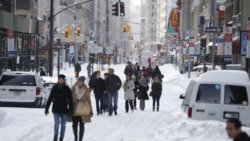From VOA Learning English, this is the Health Report in Special English.
Freezing weather can mean frostbite and hypothermia unless a person is prepared. Today we talk about how to stay warm, dry and safe.
Frostbite is damage that happens when skin is exposed to extreme cold for too long. It mainly happens on the hands, feet, nose and ears.
People with minor cases of frostbite that affect only the skin may not suffer any permanent damage. But if deeper tissue is affected, a person is likely to feel pain every time the area gets cold.
If blood vessels are damaged, people can suffer a gangrene infection. Sometimes the only way doctors can treat an injury like this is to remove frostbitten areas like fingers and toes.
Hypothermia is a condition that develops when the body cannot produce as much heat as it releases. Signs of hypothermia include uncontrollable shaking, very slow breathing and difficulty thinking clearly. Hypothermia can lead to death if the person does not receive help.
To avoid cold-related injuries, here is a simple way to remember four basic steps to staying warm. Think of COLD -- C.O.L.D.
The C stands for cover. Wear a hat and scarf to keep heat from escaping through the head, neck and ears. And wear mittens instead of gloves. In gloves, the fingers are separated, so the hands might not stay as warm as they would in mittens.
The O stands for overexertion. Avoid activities that will make you sweaty. Wet clothes and cold weather are a dangerous combination.
L is for layers. Wearing loose, lightweight clothes, one layer on top of another, is better than wearing a single heavy layer of clothing. Make sure outerwear is made of material that is water-resistant and tightly knit.
D is for dry. In other words, stay as dry as possible. Pay attention to the places where snow can enter clothing. These include the tops of boots, the necks of coats and the wrist areas of mittens or gloves.
And here are two other things to keep in mind -- one for children and the other for adults. Eating snow might be fun but it lowers the body’s temperature. And drinking alcohol might make a person feel warm. But what it really does is weaken the body’s ability to hold heat.
Next week on the Health Report: advice from experts about what to do, and not to do, to help someone who is injured by cold weather.
Freezing weather can mean frostbite and hypothermia unless a person is prepared. Today we talk about how to stay warm, dry and safe.
Frostbite is damage that happens when skin is exposed to extreme cold for too long. It mainly happens on the hands, feet, nose and ears.
People with minor cases of frostbite that affect only the skin may not suffer any permanent damage. But if deeper tissue is affected, a person is likely to feel pain every time the area gets cold.
If blood vessels are damaged, people can suffer a gangrene infection. Sometimes the only way doctors can treat an injury like this is to remove frostbitten areas like fingers and toes.
Hypothermia is a condition that develops when the body cannot produce as much heat as it releases. Signs of hypothermia include uncontrollable shaking, very slow breathing and difficulty thinking clearly. Hypothermia can lead to death if the person does not receive help.
To avoid cold-related injuries, here is a simple way to remember four basic steps to staying warm. Think of COLD -- C.O.L.D.
The C stands for cover. Wear a hat and scarf to keep heat from escaping through the head, neck and ears. And wear mittens instead of gloves. In gloves, the fingers are separated, so the hands might not stay as warm as they would in mittens.
The O stands for overexertion. Avoid activities that will make you sweaty. Wet clothes and cold weather are a dangerous combination.
L is for layers. Wearing loose, lightweight clothes, one layer on top of another, is better than wearing a single heavy layer of clothing. Make sure outerwear is made of material that is water-resistant and tightly knit.
D is for dry. In other words, stay as dry as possible. Pay attention to the places where snow can enter clothing. These include the tops of boots, the necks of coats and the wrist areas of mittens or gloves.
And here are two other things to keep in mind -- one for children and the other for adults. Eating snow might be fun but it lowers the body’s temperature. And drinking alcohol might make a person feel warm. But what it really does is weaken the body’s ability to hold heat.
Next week on the Health Report: advice from experts about what to do, and not to do, to help someone who is injured by cold weather.





